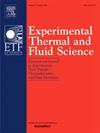湍流边界层对具有正弦图样的突然脊型粗糙度阵列的响应
IF 2.8
2区 工程技术
Q2 ENGINEERING, MECHANICAL
Experimental Thermal and Fluid Science
Pub Date : 2025-02-19
DOI:10.1016/j.expthermflusci.2025.111444
引用次数: 0
摘要
通过实验研究了正弦脊型粗糙度对中等雷诺数湍流边界层(摩擦雷诺数Reτ<;1100)响应的影响。在脊上施加一个振幅为A,波长为Λ的顺流正弦图案,同时保持脊之间的展向间距S小于边界层厚度δ.99(S /δ.99< 1)。两个正弦脊加上标准直线配置进行测试;波长为2.6δ。1.3δ.99。油滴干涉测量在脊的下游,在凹陷的部分,揭示了局部皮肤摩擦减少的正弦脊结构。采用热线风速法测量粗糙度阵列下游光滑壁面上的边界层。测量结果显示了平均速度剖面的改变和形状因子的增加。在排列脊型粗糙度和正弦脊型粗糙度构型之间的光谱含量有显著的变化。脊的存在引起了能量的明显向上移动,并在预乘能谱图的轮廓中出现了一个外峰。根据雷诺数的不同,外峰位于壁法向距离,壁单位在80到180之间。有趣的是,具有正弦模式的构型在预乘光谱中表现出更明显的能量向上移动。与具有较短波长的结构的外峰相关联的能量是标准直脊的两倍。这些结果表明,湍流边界层的响应不仅受脊向间距的影响,还受脊的波浪度的影响,这进一步加剧了湍流边界层的响应。本文章由计算机程序翻译,如有差异,请以英文原文为准。
The response of a turbulent boundary layer to a sudden ridge-type roughness array with a sinusoidal pattern
An experimental investigation was conducted to analyze the impact of a sinusoidal ridge-type roughness patch on the response of a moderate Reynolds number turbulent boundary layer (friction Reynolds number ). A streamwise sinusoidal pattern with an amplitude denoted as and a wavelength was imposed on the ridges while maintaining fixed the spanwise spacing between the ridges, , smaller than the boundary layer thickness, (). Two sinusoidal ridges are tested plus the standard straight configuration; the wavelengths being and . Oil droplet interferometric measurement conducted downstream the ridges, in the recessed part, revealed a local reduction in skin friction for the sinusoidal ridged configurations. Hot-wire anemometry was employed to measure the boundary layer on the smooth wall downstream of the roughness array. The measurements revealed a modification of the mean velocity profile and an increase in the shape factor. Significant modifications in spectral content between configurations with aligned and sinusoidal ridge-type roughness are shown. The presence of ridges caused a noticeable upward shift of energy and the emergence of an outer peak in the contour of the premultiplied energy spectrogram. The outer peak is located at a wall normal distance in wall units between 80 and 180 depending on the Reynolds number. Interestingly, configurations with sinusoidal patterns exhibited a more pronounced upward shift of energy in the premultiplied spectra. The energy associated with the outer peak for the configuration having shorter wavelength is doubled compared with standard straight ridges. These findings suggest that the response of the turbulent boundary layer is influenced not solely by the spanwise spacing of ridges but also by the waviness of the ridges, which further contributes to its intensification.
求助全文
通过发布文献求助,成功后即可免费获取论文全文。
去求助
来源期刊

Experimental Thermal and Fluid Science
工程技术-工程:机械
CiteScore
6.70
自引率
3.10%
发文量
159
审稿时长
34 days
期刊介绍:
Experimental Thermal and Fluid Science provides a forum for research emphasizing experimental work that enhances fundamental understanding of heat transfer, thermodynamics, and fluid mechanics. In addition to the principal areas of research, the journal covers research results in related fields, including combined heat and mass transfer, flows with phase transition, micro- and nano-scale systems, multiphase flow, combustion, radiative transfer, porous media, cryogenics, turbulence, and novel experimental techniques.
 求助内容:
求助内容: 应助结果提醒方式:
应助结果提醒方式:


